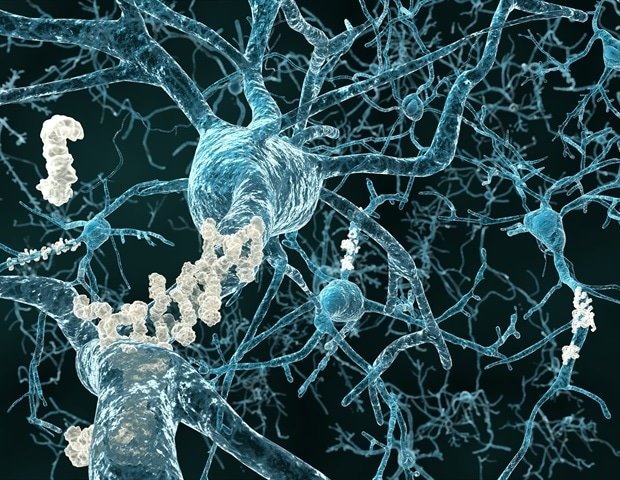A research team at the University of Barcelona Neuroscience Institute (UBneuro) has led a study that describes a new molecular mechanism that affects RNA processing and alters the process of protein synthesis in the brains of Alzheimer’s patients. The study, which has been conducted in post-mortem patient samples and in animal models of the disease, will help design future treatments to treat this dementia and other neurological disorders.
Cristina Malagelada, who led the study, and Genís Campoy-Campos, its first author, published the paper in Nucleic Acid Research. Malagelada is a professor at the UB School of Medicine and Health Sciences and at UBneuro and, along with Campoy-Campos, are members of the Center for Biomedical Research Network on Neurodegenerative Diseases (CIBERNED).
A new function for the RTP801 protein
Alzheimer’s disease is the most common type of dementia and causes a gradual decline in cognition, memory and language skills, as well as emotional and psychiatric disturbances. It is characterized by the accumulation of β-amyloid plaques outside neurons and hyperphosphorylated tau protein inside neurons, which alter brain function and cause cell death.
Now, this study reveals a previously unknown role for the protein RTP801, a stress response factor that is abundant in patients with neurodegenerative diseases such as Alzheimer’s disease. According to the findings, this protein can alter the molecular mechanisms that support neuronal survival by affecting the translation of RNA into proteins.
Malagelada says that “until now we knew that the protein RTP801, which is found in hippocampal neurons, is involved in Alzheimer’s pathology, as we published in a previous article (Cell death and disease2021). Then, we discovered that levels of this protein were significantly elevated in both mouse models of Alzheimer’s and in postmortem samples from patients, and these values correlated with disease progression.”
“At a mechanistic level, we observed that reducing the expression of RTP801 prevented cognitive deficits and inflammation, specifically by attenuating the activation of the hippocampal inflammasome, that is, the machinery that processes cytokines in inflammatory responses and drives gliosis (reactivation and proliferation of glial cells”, continues the expert.
Why is this mechanism vital to neuronal health?
The study describes how the RTP801 factor negatively regulates the activity of the tRNA ligase complex (tRNA-LC), which is critical for processing RNA molecules. In the context of Alzheimer’s disease, higher levels of RTP801 can inhibit this complex and cause problems in RNA splicing and the subsequent production of related proteins, such as brain-derived neurotrophic factor (BDNF), exacerbating cognitive problems in a model Alzheimer’s disease mouse.
Campoy-Campos notes that “in this study, we found that high levels of RTP801 interfere with the tRNA ligase complex, which is responsible for RNA processing, specifically in the process of ligation of its exons after introns are spliced. The process takes place in both the messenger RNA – which contains the information to make the protein – and the transfer RNAs, which carry the amino acids to translate it.” The researcher emphasizes that “this process is crucial for the correct synthesis of proteins in the ribosome, the cellular organelles where the translation of RNA into proteins takes place.”
Interestingly, this interaction between RTP801 and the tRNA ligase complex also affects the RNA binding of a transcription factor called XBP1s. This factor helps cells cope with stress in the endoplasmic reticulum – an organ formed by a series of reservoirs and membrane-bound cavities in the cell’s cytoplasm – and promotes the expression of BDNF, a neurotrophin vital for synaptic transmission, memory and the survival of neurons.
Genís Campoy-Campos, first author
Altered RNA processing – a consequence of high levels of RTP801 – is extremely damaging to neurons, disrupting their ability to synthesize proteins and respond to stress. As Malagelada points out, this altered RNA processing adds a new toxic component to the hitherto known progression of Alzheimer’s disease. “We now bring to the table the toxicity of unbound RNA and its implications as a novel neurodegenerative mechanism in Alzheimer’s disease,” he says.
Enhancing future therapies for the treatment of neurodegenerative diseases
The discovery of new functions of the RTP801 protein could open up future therapeutic options to address the treatment of neurodegenerative pathologies and the maintenance of brain function and neuronal health. In this sense, Malagelada points out that “if we can design inhibitors of the RTP801 protein — which we are currently working on — or preserve the activity of the tRNA ligase complex, we could specifically block the most toxic functions of this agent and to preserve basic neuronal processes’.
The researchers conclude that “this offers a new set of innovative therapeutic options in the context of these neurological disorders.”
Source:
Journal Reference:
Campoy-Campos, et al. (2024). RTP801 interacts with the tRNA ligase complex and deregulates RNA ligase activity in Alzheimer’s disease. Nucleic acid research. doi.org/10.1093/nar/gkae776.
